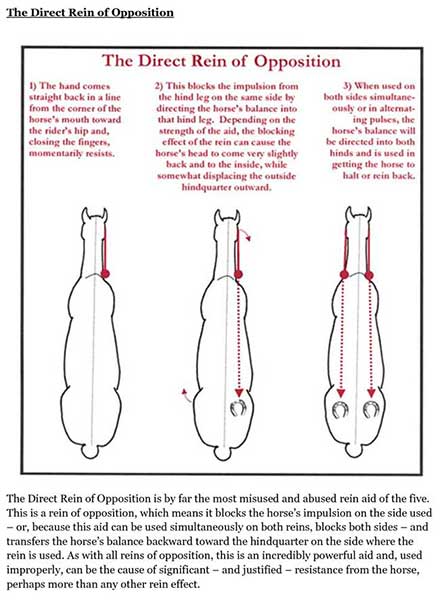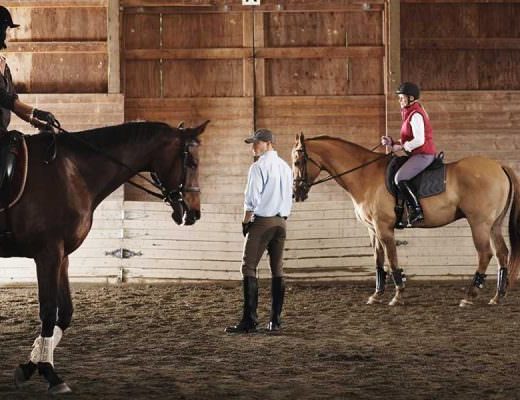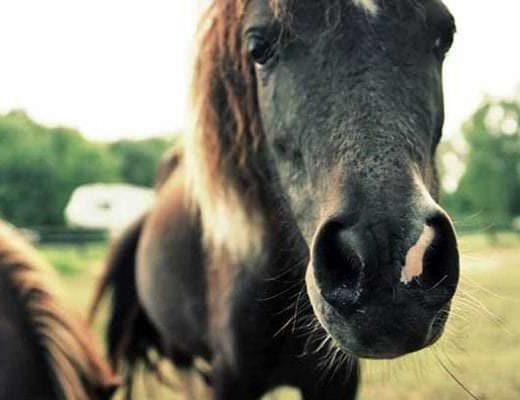In the first part of this article, we covered the Rules of the Aids, along with introducing and describing the Half Halt and Reverse Half Halt. We now continue on, in a very logical way, to discuss the Direct and Indirect Rein. These two aids are the means of directing, guiding and helping to shape the horse.
Direct Rein
The simplest and most straightforward rein aid, is appropriately termed a Direct Rein (now on referred to as DR). Also commonly referred to as an opening rein, plow rein, inside rein, or considered to be the common means of rein control in English disciplines. The DR is commonly used to “open” to the side you want the horse to turn to, and a certain amount of traction or pull applied.
The DR is capable of greater refinement, and specific control than it has been given credit for. Let's first go over some of the key points of the DR.
- WEIGHT DISTRIBUTION: The DR puts the weight on the inside front limb.
- BEND: The horse is bent in the direction of travel – bend left, travel left.
- EXCLUSIVE MOVEMENT: Turn on the forehand.
In the illustration to the left we see a basic model of a horse viewed from above. This is assuming we are using a right DR. The red X marks where the majority of the weight will be placed, the right foreleg. This is the leg that the horse will pivot around. What this also means is that by using a DR, we are placing the horse on the forehand.
The red line directing us towards the left, is indicative of the direction that the haunches will swing in the motion. This action is what disconnects the horse's direction (the forehand) from the driving force or energy (the haunches). The DR disconnects these two elements, making it difficult if not impossible for the horse to propel himself forward into the direction of travel with full power. For example, in a wide turn using the DR, the horse will have a considerable amount of force in propelling himself forward. In a tight turn or pivot on the forehand, that energy will propel the horse's haunches sideways.
Finally, the blue arrow directed towards the horse's right hind leg is indicative of the direction of the rein's action. When using the reins, you have the option of moving forward, backward, up, down, left and right. The arrow represents backward, in a parallel line to the horse's body when straight.
Indirect Rein
The second means of direction at your hands, is the Indirect Rein (now on referred to as IR). This rein is similar in action to a neck rein, although the IR follows different rules than a neck rein.
- WEIGHT DISTRIBUTION: The IR puts the weight on the outside hind limb.
- BEND: The horse is bent in the opposite direction of travel – bend left, travel right.
- EXCLUSIVE MOVEMENT: Turn on the haunches.
In the illustration to the left we see again a basic model of a horse viewed from above. We are basing the picture on the assumption that we are using a right IR. The red X marks where the weight of the horse is being supported, the limb that the body will pivot around. This time, it is the opposite hind leg, both from the rein we are using, and from the DR's weight placement.
The red arrow points to the direction that the forehand travels, around the pivoting hind limb. The motion of the forehand, unlike the DR, aligns the forehand with the haunches (direction and propulsion). This makes the IR ideal to help set the horse up for movements that require lots of propulsion straight forward (i.e. canter departs, extended or collected gaits, etc).
The blue arrow is the direction of the rein action when using the IR. As before, we have the options of moving the rein forward, backward, up, down, left and right. Our action is in a diagonal fashion – left and backward, in alignment with the leg that will be weight bearing, the left hind leg.
How both of these rein aids interact with each other is simple and complex. They have the capability to be used alone, or together. They can also be used in conjunction with the HH and RHH. Any of these combinations will create certain movements from the horse, and it is the refinement of balancing between the rein aids that is the core of riding skill.
Dissecting movements
Exactly how are movements created using the rein aids that we've already discussed? Let's try to approach the movements of the horse critically.
First we should define exactly what it is we are looking for, and why. Every idea must have reason behind it. What are “movements” and why are they important? Taken down to it's most basic purpose, any act of riding or training is in some way to define, direct, teach and be able to recall a movement, or series of movements, with a specific aid or cue. Why do we spend such a large portion of our time with horses, working towards influencing, controlling, or directing the walk, trot, canter, and gallop?
- USEFULNESS : Horses were not always used primarily for pleasure or hobby. Their employ started to lighten our work load, and increasing theirs. The ability to specifically control how the horse moved was an important way to make sure the work was done in a quick, efficient manner, and with less risk of injury to horse or human. Imagine trying to direct a 6-horse coach without the ability to speed up or slow down in a turn.
- PHYSICAL CONDITIONING : Now that horses are used in competitions, and are considered to be athletes along with their counterparts, the importance of muscle health is number one. Unlike their counterparts, horses cannot be told to “do 50 push-ups”, so it is by positioning the horse to use his body in a certain way that conditions him. Just as a person can lift a heavy weight by bending at the back, they can be more efficient, lift more weight and do less physical damage by lifting with their legs and keeping the back relatively straight.
- A BETTER RIDE : Like a graceful ballet dancer, a strong horse whose movements have been refined through physical conditioning will move more beautifully. What this means to us as riders, is that the horse is also more enjoyable to ride. Their gaits become smoother to ride because the motion is consistent rather than erratic, the turns and maneuvers are balanced and elegant.
So, knowing the purpose to pursuing the development and refinement of various movements in the horse, lets dig deeper.
Movements can be divided up into different groups, based on how they change the way the horse uses himself, and also the direction of travel.
Straight forward
- Walk, Trot, Canter, Gallop
- Lengthened or Shortened Walk, Trot, Canter
- Extended or Collected Walk, Trot, Canter
- Piaffe, Passage, Terre Terre
Lateral (at any pace)
- Leg Yield
- Shoulder In
- Half Pass
- Full Pass or Side Pass
Standing
- Any of the Airs including Levade and Courbette
This is a very basic, and incomplete list of how the various movements could be divided up. There are certain movements that could fall into several categories as well – the Terre Terre being one of them. It qualifies as a straight forward movement, however can also be considered as an Air because of it's rearing and leaping motion.
Primarily it is the HH that directs and controls the straightforward movements, and most certainly the standing movements. It is because elevation is the key to straightness, when the horse's neck reaches a certain amount of elevation, which is specific to the individual horse, it makes it impossible for the horse to also have any significant amount of bend through the spine. Elevation fixes a crooked horse. Elevation also kills the forward energy, so it is vital that both are balanced. Teaching a horse to respond to the HH with a light rein, will enable the rider to be more subtle in asking for elevation to straighten the horse's spine, and also allow them to balance between increasing elevation and losing impulsion.
The Indirect and Direct rein aids will control the lateral movements, but you cannot forget the HH either. The HH plays a secondary role in the lateral movements. Without the HH, it is easy for the horse to move to quickly in the movements, and lose the physical benefit, and also be less precise in the movement. Since the HH controls elevation too, any increase in elevation increases the amount of sideways movement you get. With maximum elevation, you kill all the forward energy of the horse. When you then add energy through either the whip or the legs, you get straight sideways movement.
The lateral movements also require a balancing act between the Direct and Indirect rein, too much of one or the other in a specific movement can change it completely. For example, in the shoulder in, your primary rein is going to be an indirect rein, however too much indirect rein will turn your shoulder in, into a turn on the haunches.









